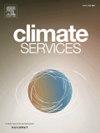Arctic Climate Threat Indicator Set for Municipal Decision-Making
IF 4.5
3区 环境科学与生态学
Q2 ENVIRONMENTAL SCIENCES
引用次数: 0
Abstract
Rapid Arctic warming triggering natural hazards necessitates new climate risk and social impact tracking. During a series of interviews, mayors of Fairbanks, Alaska; Yellowknife, Canada; and Luleå Sweden identified the need for climate monitoring tools focused on urban Arctic environments. In response, this paper introduces the Arctic Climate Threat Indicator Set (ArCTISt) as a series of nine indicators and accompanying codes for Arctic municipal use. Four climate themes were incorporated into ArCTISt after identification as most relevant to constituent and municipal planning concerns by mayors: (1) extreme temperature variation, (2) extreme precipitation events, (3) wildfire risk, and (4) permafrost thaw. This study demonstrates an example use case, applying station records and projections from the World Climate Research Program’s Coupled Model Intercomparison Project (CMIP6) to project urban Arctic climate changes. ArCTISt first constructs a multi-model ensemble for each city, combining identified top-performing models and evaluating their ability to simulate city-specific seasonal patterns. Indicator results are then calculated using station and model inputs for a historical period (1981–2010) and future projections up to 2100. Findings indicate over 40 new heat wave days per year in all cities, intensifying precipitation in Fairbanks and Luleå, increasing wildfire risk, and intensified permafrost thaw potential in Fairbanks and Yellowknife under high emissions scenarios. Using these indicators, Arctic cities can better determine the most significant environmental challenges for municipal planning. Unlike other sustainability indicators requiring significant data collection and analysis, ArCTISt builds easily interpretable future scenarios and accompanying graphics designed for constituent communication and funding initiatives.
用于市政决策的北极气候威胁指标集
北极快速变暖引发自然灾害,需要对新的气候风险和社会影响进行跟踪。在一系列采访中,阿拉斯加州费尔班克斯市的市长;耶洛奈夫,加拿大;瑞典的luleef确定了对气候监测工具的需求,重点是北极城市环境。作为回应,本文介绍了北极气候威胁指标集(ArCTISt),作为一系列9个指标和随附的北极城市使用代码。四个气候主题在被市长确定为最相关的组成和市政规划问题后被纳入artist:(1)极端温度变化,(2)极端降水事件,(3)野火风险,(4)永久冻土融化。本研究展示了一个用例,应用来自世界气候研究计划耦合模式比对项目(CMIP6)的站点记录和预测来预测北极城市气候变化。艺术家首先为每个城市构建了一个多模型集合,将识别出的表现最好的模型结合起来,并评估它们模拟城市特定季节模式的能力。然后利用台站和模式输入的历史时期(1981-2010年)和到2100年的未来预测计算指标结果。研究结果表明,在高排放情景下,所有城市每年新增热浪天数超过40天,费尔班克斯和吕勒拉夫的降水加剧,野火风险增加,费尔班克斯和耶洛奈夫的永久冻土融化潜力增强。利用这些指标,北极城市可以更好地确定城市规划中最重大的环境挑战。与其他需要大量数据收集和分析的可持续发展指标不同,artist构建了易于解释的未来情景,并为成分沟通和资助计划设计了附带的图形。
本文章由计算机程序翻译,如有差异,请以英文原文为准。
求助全文
约1分钟内获得全文
求助全文
来源期刊

Climate Services
Multiple-
CiteScore
5.30
自引率
15.60%
发文量
62
期刊介绍:
The journal Climate Services publishes research with a focus on science-based and user-specific climate information underpinning climate services, ultimately to assist society to adapt to climate change. Climate Services brings science and practice closer together. The journal addresses both researchers in the field of climate service research, and stakeholders and practitioners interested in or already applying climate services. It serves as a means of communication, dialogue and exchange between researchers and stakeholders. Climate services pioneers novel research areas that directly refer to how climate information can be applied in methodologies and tools for adaptation to climate change. It publishes best practice examples, case studies as well as theories, methods and data analysis with a clear connection to climate services. The focus of the published work is often multi-disciplinary, case-specific, tailored to specific sectors and strongly application-oriented. To offer a suitable outlet for such studies, Climate Services journal introduced a new section in the research article type. The research article contains a classical scientific part as well as a section with easily understandable practical implications for policy makers and practitioners. The journal''s focus is on the use and usability of climate information for adaptation purposes underpinning climate services.
 求助内容:
求助内容: 应助结果提醒方式:
应助结果提醒方式:


